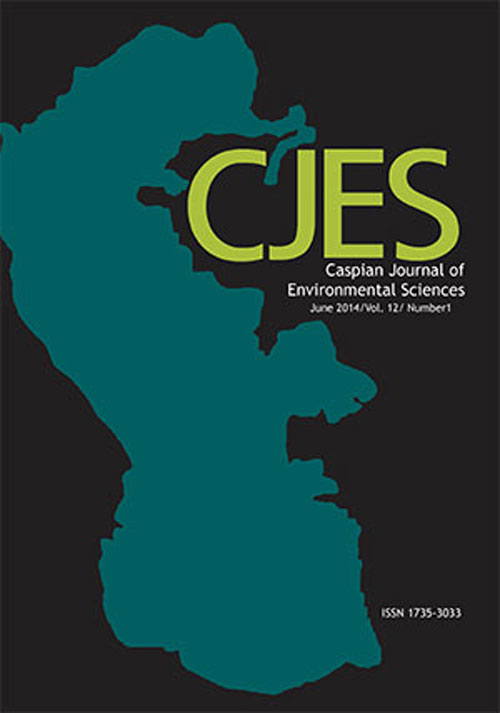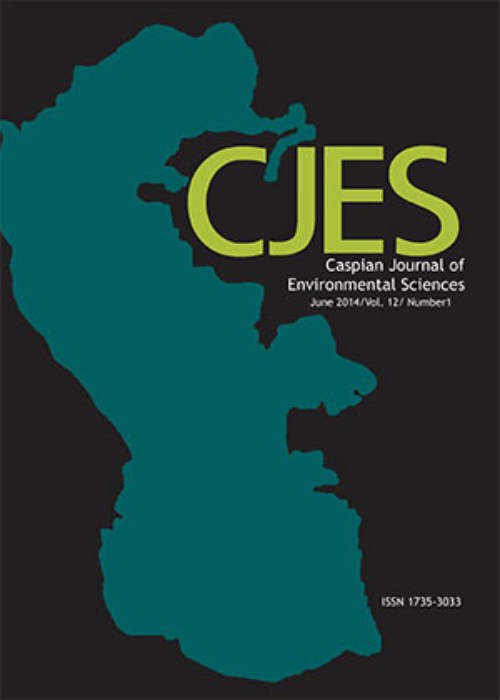فهرست مطالب

Caspian Journal of Environmental Sciences
Volume:14 Issue: 4, Autumn 2016
- تاریخ انتشار: 1395/10/12
- تعداد عناوین: 8
-
-
Pages 285-298Anesthesia is considered to be the best way to ensure animal welfare during handling etc. Clove oil and electronarcosis are among the most popular chemical and physical anesthetics used in fisheries and biology; however there is a little information available on the effect of anesthesia using direct electric current in fish. In the present study, the impacts of clove oil (30 mg.l-1) and electro-anesthesia (constant direct current, 0.5 v.cm-1) (DC) were assessed in common carp, Cyprinus carpio during narcotic stage in two experimental sets. Experiment 1 was conducted to quantitatively compare induction of anesthesia and recovery time. The biochemical and hematological effects of anesthetics were analyzed as experiment 2. The results revealed that induction and recovery times in fish anesthetized with electric current were significantly lower than clove oil treatment. Significant differences were observed in cortisol concentrations, red blood cells and mean corpuscular hemoglobin concentration between anesthetic methods. Our results suggest that constant direct current electronarcosis was more quickly than clove oil and associated with lower side effects in common carp.Keywords: Clove oil, Electro, anesthesia, Cyprinus carpio, Hematology, Plasma biochemistry
-
Pages 299-310Recent studies showed that remote sensing (RS) is an effective, efficient and reliable technique used in almost all the areas of earth sciences. Remote sensing as being a technique started with aerial photographs and then developed employing the multi-spectral satellite images. Nowadays, it benefits from hyper-spectral, RADAR and LIDAR data as well. This potential has widen its applicability in the various areas and professional disciplines much more efficiently as never been before. One of the areas that remote sensing has been applied well and has become one of the indispensable tools for the earth sciences scientists are geologic and mineral exploration studies and especially prospection stages of these studies. In this research, it was tried to determine and to map zeolite sites in Gördes region (Turkey) which were formed as alteration products having high level of water content and developed in volcanic rock beds by the help of remote sensing and GIS. The study area is about 400 km2 and located at the North-East of Manisa Province. The results confirmed that the zeolite areas obtained by classical exploration techniques can be determined using remote sensing techniques such as Feature Oriented Principal Component Analysis (PCA). Other zeolite areas in the same scene were also determined or at least predicted by this computer learning process through the same remote sensing image analyses.Keywords: zeolite, Feature Oriented Principal Component Analysis, Landsat images, Gordes
-
Pages 311-320In this study, the chronic toxic effects of Pb (II) on common carp, Cyprius carpio were investigated using several biomarkers at different levels of biological functions for assessing changes in ecosystem quality. In a bioassay, common carp juveniles were individually exposed to different dose of heavy metal, Pb II (0, 0.45, 0.89, 1.34 mg.l-1) for 28 days. Morphological indices such as hepatosomatic index, condition factor and lipid peroxidation (LPO) level and also the activities of superoxide dismutase (SOD) and catalase (CAT) were measured. These results indicated that there was significant lower condition factor in fish exposed to the highest concentration of Pb (pKeywords: Cyprius carpio, Pb, Lipid peroxidation, Oxidative stress, Morphological indices
-
Pages 321-329Helicopter landing sites in proximity to the forest fire-risk zones are necessary for the delivery of supplies and fire emergency response teams. In this paper, we initially prepared forest fire risk map using Random Forest algorithm by overlaying the effective factors on fire occurring including vegetation types, physiographic, climatic and human factors. Then, three variants of natural candidate sites for helicopter landing were designed by analysis of terrain slope, site areas, canopy gap, and fire risk zone. The value of each variant was evaluated using proximity analysis. In this analysis, proximity to river, area covered by landing and time cost of response teams from landing to fire zone was estimated. The optimum variant was selected by Analytical Hierarchy Process. Based on results, it strongly recommends the use of the variant one whenever possible, since the time cost and proximity to the river were lower and the area covered was higher than other variants.Keywords: Risk map, Firefighting, Helicopter landing, Time cost, Golestan National Park
-
Pages 331-338Nowadays it is very desirable to investigate and discover new antibacterial and antioxidant agents from natural products and medicinal plants. The current study was conducted to examine the antimicrobial and antioxidant properties of an endemic plant named Caspian saffron, Crocus caspius. After collecting C. caspius and drying them in the shade, ethanol, methanol and hydroalcohol extracts were prepared using maceration method. The amount of phenols and flavonoids measured in this study 2, 2_diphenyl-1_picrylhdrazyl (DPPH) test and disc diffusion method were used to evaluate antioxidant and antimicrobial activities, respectively. According to the results, phenols and free radical scavenging capacity were at highest level in the hydroalcoholic extract and flavonoids at highest level in the ethanol extract. More antioxidant activity of extracts was obtained in the higher concentrations. The highest amount of inhibitor for antimicrobial activity was in methanol extract using Candida albicans. The results indicated the potentiality of C. caspius extract to use as bio-preservatives and antimicrobial agents. However, further investigations are needed in the future in this regard.Keywords: Antimicrobial, Antioxidant, DPPH assay, Phenol, Flavonoid, Crocus caspius
-
Pages 339-350Evolution of the concept of environmental damages is one of the aspects of development in international environmental law. In fact, after increasing global environmental problems and lack of efficiency in international environmental law to prevent the damage, unifying the concept of environmental damage in the law is being considered as a solution for this matter. Moreover, development of international laws including customary and conventional law play an important role in describing the environmental damage. For instance, codification and elaboration of over a thousand bilateral or multilateral treaties and agreements on international environmental laws verify the role of these law in development of the content and substance in this legal field. However, some aspects of the environmental damages concept remain unclear. So, in the present study, with analytical approach we are trying to analyze the development of the concept of environmental damage in International environmental law. It would also be ensured that determining and defining the environmental damage are important for addressing environmental problems. In addition to prevent and reduce the environmental pollution, it can be considered as a tool to establish the international responsibility in the case of Trans - boundary damage to environment. The conclusion of this paper is based on the progressive development of the environmental damage concept in international law.Keywords: International environmental law, Environmental damage, Environmental pollution, International responsibility, compensation
-
Pages 351-362Nowadays, tourism related activities are widely regarded as key tools for rural development. Accordingly, it would be worthwhile to estimate the recreational value of Javaherdeh Village, in order to propose a better management plan for attracting more tourists to this place. This research employed a contingent valuation method to determine the recreational value and individual willingness to pay (WTP) for outdoor recreation of Javaherdeh. Logit model and maximum likelihood method were employed for determining WTP and it's determinants. The data were collected by completing double-bounded dichotomous choice questionnaires and interviewing with 220 individuals who visited the village. Results revealed that 96% of individuals were willing to pay for visiting the village. Additionally, results indicated that the variables including monthly income, overnight staying, number of visits, attitude, satisfaction with the quality of facilities and proposed fee (bid) had a significant effect on the probability of individuals willingness to pay. Mean value of willingness to pay for each visitor per year was 41,960 Iranian Rials (IRR) and annual outdoor recreation value of Javaherdeh was 6,128,430,000 IRR. The tourists WTP will be helpful to prepare guidelines for possible increases in entrance fees and efficient sustainable management of the village.Keywords: Contingent valuation method, Recreational value, Willingness to pay, Rural tourism
-
Pages 363-371This study aimed to investigate the diversity and types of arbuscular mycorrhizal fungi (AMF) associated with the wild service tree, Sorbus torminalis (L.) Crantz in spring and autumn followed by identifying similarities among the different study sites. Three different sites were selected including Kheiroud, Lalis, and Tarkin, in the Hyrcanian forests, north of Iran. Five rhizosphere soil samples were collected from each site, and the spores were extracted. Based on their morphological features, five species of AMF belonging to two families, i.e., Claroideoglomeraceae (two species) and Glomeraceae (three species) were identified. The species richness of the studied sites was identical with only the Kheiroud site presenting an additional species. Glomus badium was the most common AMF species in Kheiroud and Lalis in spring and autumn. However, the most common species in Tarkin was Septoglomus constrictum. The ShannonWiener indices of diversity and evenness and Simpsons index of dominance (Ds) showed no significant differences among the studied sites in the two seasons. In sum, it is recommended that the colonized wild service tree seedlings be produced with the more relevant species identified in this study than with commercial sources.Keywords: Arbuscular mycorrhizae, Claroideoglomeraceae, Glomus badium, Glomeraceae, Sorbus torminalis


